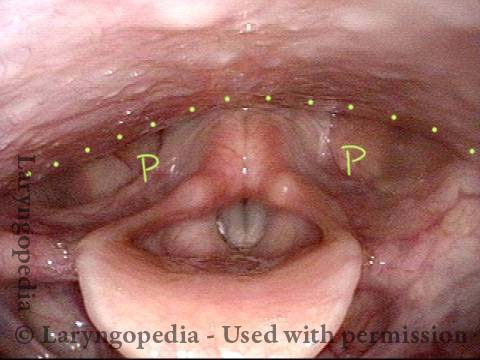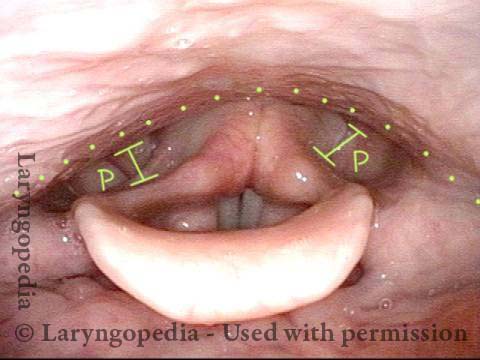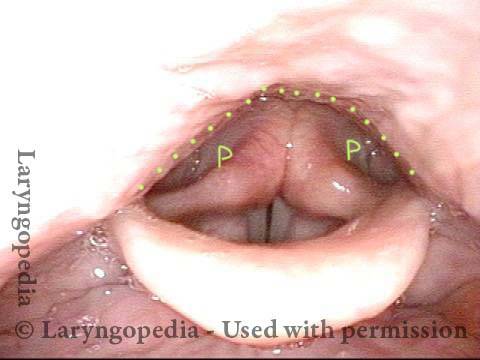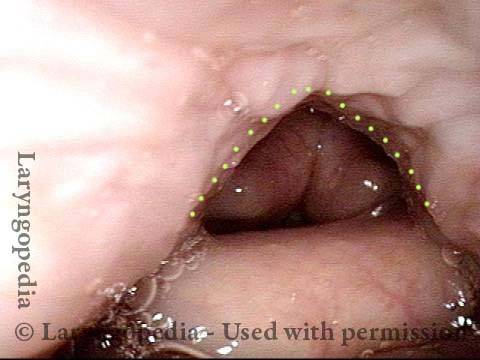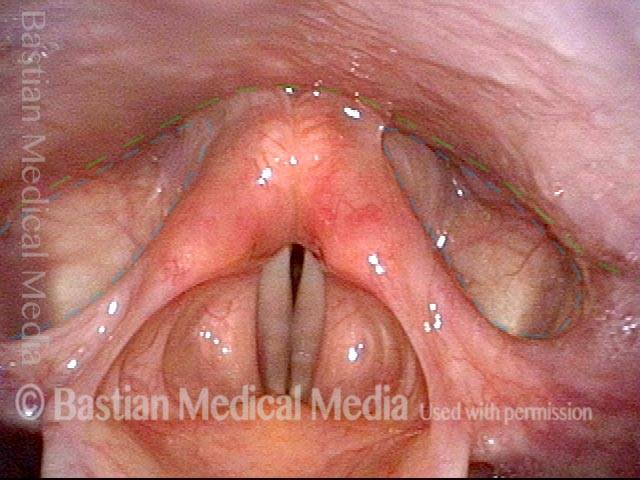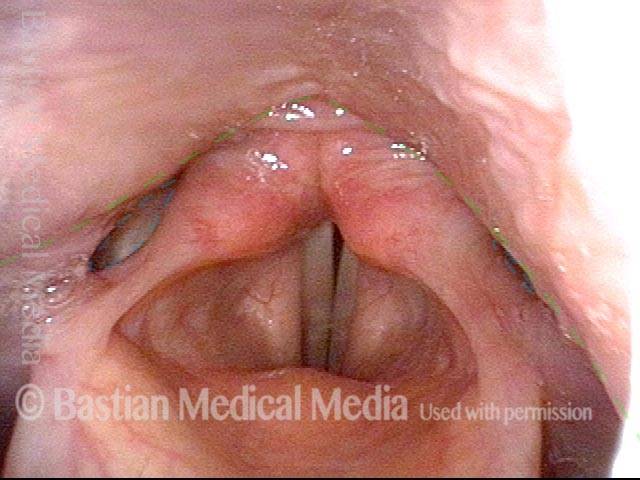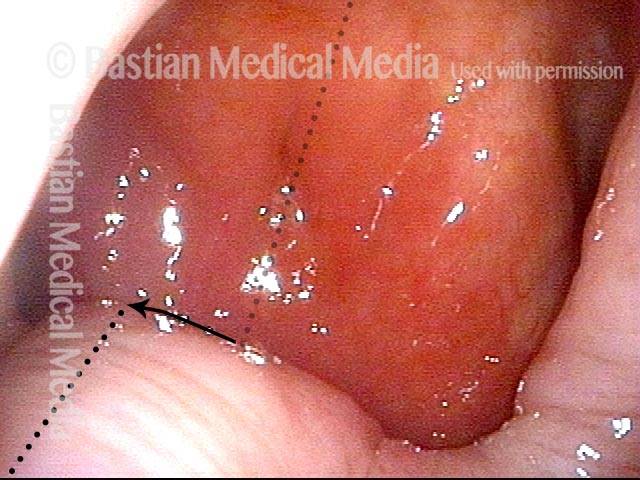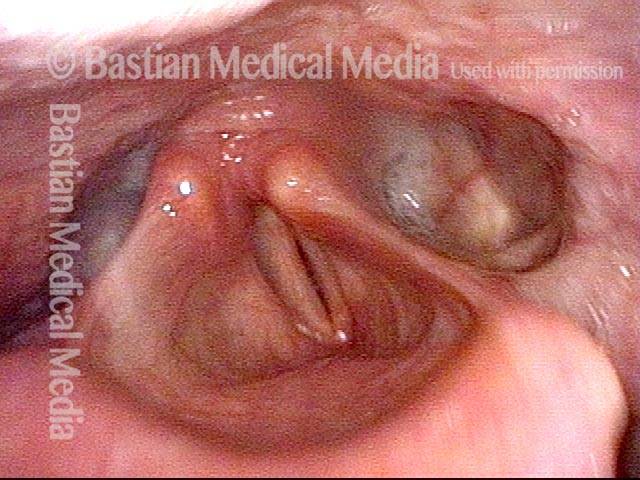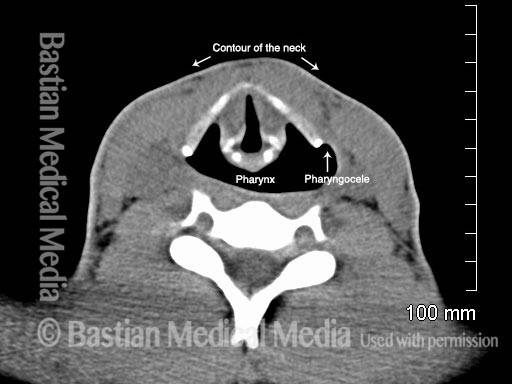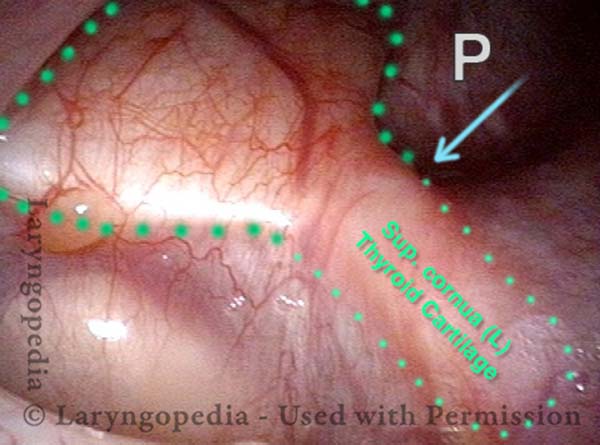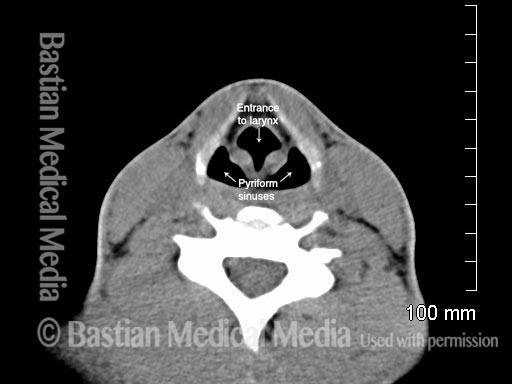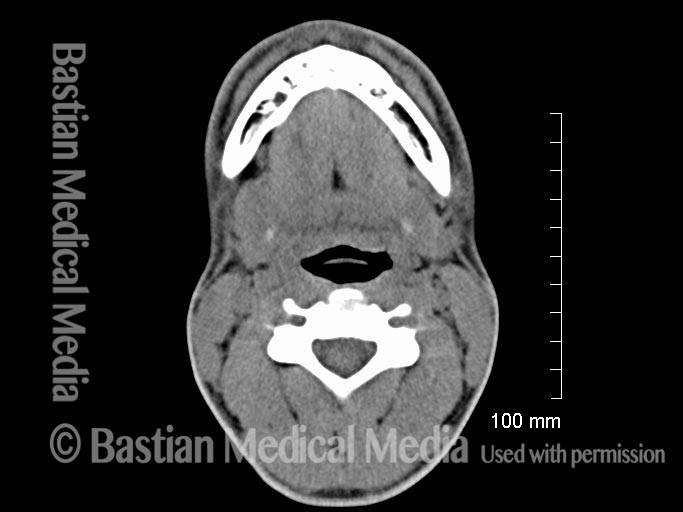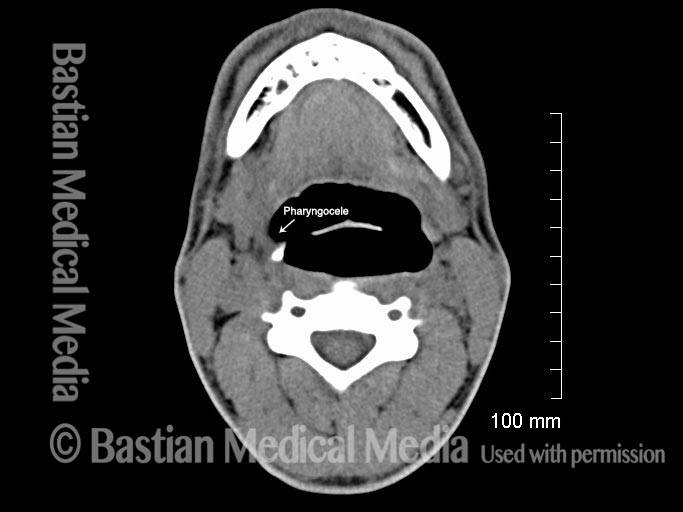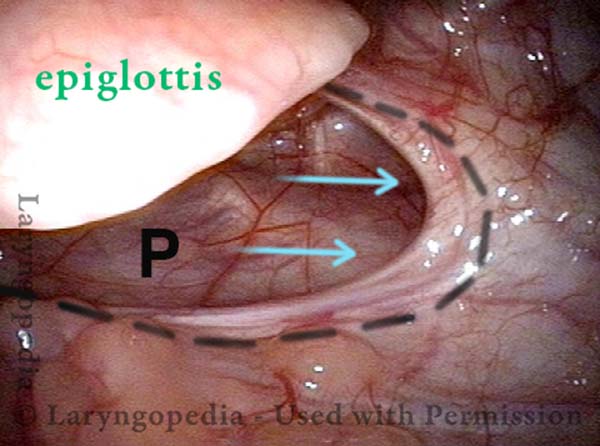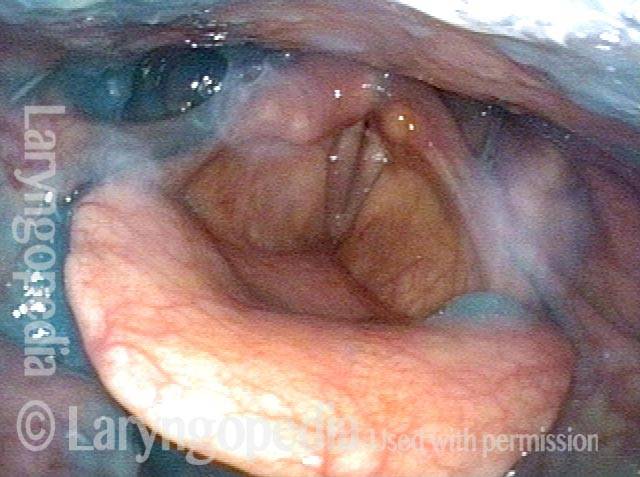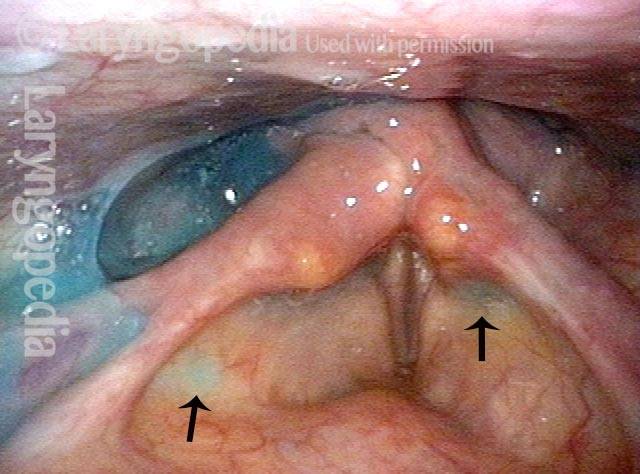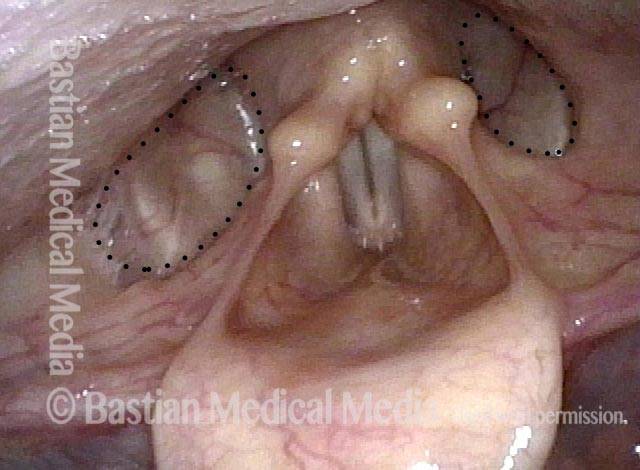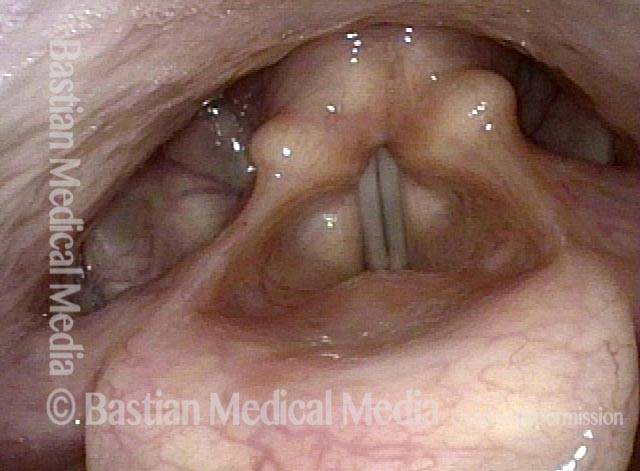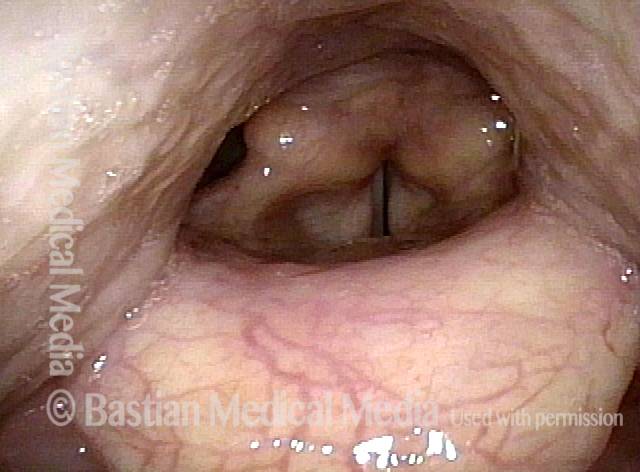Pyriform sinus refers to the pear-shaped fossa (Latin for “trench”) just lateral to the laryngeal entrance. Its medial surface is the aryepiglottic cord; laterally it is bounded by the thyroid cartilage, and posteriorly by the low posterior pharyngeal wall. The pyriform fossas and post-arytenoid area together constitute the “swallowing crescent,” which channels swallowed material just before it enters the esophagus, behind the larynx.
Inappropriate Pharynx Contraction Is A Component of (MTD)
Rest Position of Pharynx (1 of 6)
This talented teenaged classical singer is bothered by a sense of effort, fatigue, and discomfort when attempting her high soprano notes. Quiet breathing (seen here) establishes the rest position of pharynx (dotted lines), with wide open pyriform sinuses (P). A thin sheet of muscle is just beneath the mucosa.
Rest Position of Pharynx (1 of 6)
This talented teenaged classical singer is bothered by a sense of effort, fatigue, and discomfort when attempting her high soprano notes. Quiet breathing (seen here) establishes the rest position of pharynx (dotted lines), with wide open pyriform sinuses (P). A thin sheet of muscle is just beneath the mucosa.
Inactive Pharynx Musculature (2 of 6)
Pharynx muscle should be inactive (not contracted) until a singer reaches the top few notes of his or her range. This singer is producing voice at B3 (247 Hz), a low note for this singer. The pharynx musculature remains inactive, like in photo 1.
Inactive Pharynx Musculature (2 of 6)
Pharynx muscle should be inactive (not contracted) until a singer reaches the top few notes of his or her range. This singer is producing voice at B3 (247 Hz), a low note for this singer. The pharynx musculature remains inactive, like in photo 1.
Contracted Pharynx (3 of 6)
At B4 (495 Hz), which is only middle voice, the pharynx begins to contract, inappropriately. Note the smaller diameter of pyriform sinuses (see lines), and the more curved pharyngeal wall contour (dotted lines).
Contracted Pharynx (3 of 6)
At B4 (495 Hz), which is only middle voice, the pharynx begins to contract, inappropriately. Note the smaller diameter of pyriform sinuses (see lines), and the more curved pharyngeal wall contour (dotted lines).
Contracted Pharynx (4 of 6)
At E-flat 5, still far from upper range, the pharynx is contracting a lot, and again inappropriately. This degree of contraction should not be seen until much higher in her range. If she sings continually at this pitch and higher, she will experience paralaryngeal discomfort and effort, and sometimes a “reaching up” vocal quality.
Contracted Pharynx (4 of 6)
At E-flat 5, still far from upper range, the pharynx is contracting a lot, and again inappropriately. This degree of contraction should not be seen until much higher in her range. If she sings continually at this pitch and higher, she will experience paralaryngeal discomfort and effort, and sometimes a “reaching up” vocal quality.
Greater Contraction of Pharynx (5 of 6)
Now at “only” F#5 (740 Hz), the contraction of the pharynx is maximal and pyriform sinuses closed. For a soprano, this degree of contraction is ideally not seen before reaching C6 (1046 Hz) or higher! As the pharynx is not designed for sustained contraction, upper voice singing will be impossibly uncomfortable for her.
Greater Contraction of Pharynx (5 of 6)
Now at “only” F#5 (740 Hz), the contraction of the pharynx is maximal and pyriform sinuses closed. For a soprano, this degree of contraction is ideally not seen before reaching C6 (1046 Hz) or higher! As the pharynx is not designed for sustained contraction, upper voice singing will be impossibly uncomfortable for her.
Phonating Larynx (6 of 6)
Close-range visualization of the phonating larynx (note the vibratory blur) shows a characteristic posterior commissure gap (arrows). This finding is also characteristic of MTD.
Phonating Larynx (6 of 6)
Close-range visualization of the phonating larynx (note the vibratory blur) shows a characteristic posterior commissure gap (arrows). This finding is also characteristic of MTD.
Pharynx Contraction
Pharynx contraction (1 of 2)
Laryngopharyngeal view of a young woman, phonating at F4 (~349 Hz). Here the pharynx is relaxed: notice the broad arc of the pharyngeal wall (green dotted line) and the widely open pyriform sinuses (blue dotted lines).
Pharynx contraction (1 of 2)
Laryngopharyngeal view of a young woman, phonating at F4 (~349 Hz). Here the pharynx is relaxed: notice the broad arc of the pharyngeal wall (green dotted line) and the widely open pyriform sinuses (blue dotted lines).
Pharynx contraction (2 of 2)
Same patient, now phonating at C5 (~523 Hz). The pharynx has contracted: notice the narrower, more pointed arc of the pharyngeal wall (green dotted line) and that the pyriform sinuses (blue dotted lines) are nearly closed. In this relatively young soprano, this degree of pharyngeal contraction should not occur until she sings as high as G5 (~784 Hz) or higher. This singer is experiencing loss of expected upper range—a lowered “muscular” ceiling of the voice.
Pharynx contraction (2 of 2)
Same patient, now phonating at C5 (~523 Hz). The pharynx has contracted: notice the narrower, more pointed arc of the pharyngeal wall (green dotted line) and that the pyriform sinuses (blue dotted lines) are nearly closed. In this relatively young soprano, this degree of pharyngeal contraction should not occur until she sings as high as G5 (~784 Hz) or higher. This singer is experiencing loss of expected upper range—a lowered “muscular” ceiling of the voice.
Palate Deviation Showing Hemi-palate Paralysis
Palate paralysis (1 of 2)
View of the upper surface of the palate from within the nasopharynx. Due to this patient's hemi-palate paralysis, the palate deviates to one side, such that its midline (darker dotted line) no longer matches the nasopharynx's midline (lighter dotted line).
Palate paralysis (1 of 2)
View of the upper surface of the palate from within the nasopharynx. Due to this patient's hemi-palate paralysis, the palate deviates to one side, such that its midline (darker dotted line) no longer matches the nasopharynx's midline (lighter dotted line).
Palate and pharyngeal paralysis (2 of 2)
Panorama of the laryngopharynx. Note the capacious left pyriform sinus (right of photo), one strong indicator of paralysis of the pharynx on that side.
Palate and pharyngeal paralysis (2 of 2)
Panorama of the laryngopharynx. Note the capacious left pyriform sinus (right of photo), one strong indicator of paralysis of the pharynx on that side.
Pharyngocele
X-ray view at vocal cord level during quiet breathing [without Valsalva] (1 of 9)
A 20-year-old man complains that his neck expands and that he has pain while playing the trumpet. This radiographic image is at the level of the vocal cords, during quiet breathing; at this point, the pharyngeal dilation and pharyngocele are not yet seen. Compare with image 2.
X-ray view at vocal cord level during quiet breathing [without Valsalva] (1 of 9)
A 20-year-old man complains that his neck expands and that he has pain while playing the trumpet. This radiographic image is at the level of the vocal cords, during quiet breathing; at this point, the pharyngeal dilation and pharyngocele are not yet seen. Compare with image 2.
Another X-ray view at vocal cord level [with Valsalva] (2 of 9)
Same view as in image 1, except that the patient is performing a Valsalva maneuver with a lip-stop, to simulate trumpet playing. Whereas in image 1 the pharynx is completely collapsed, here it is inflated with air. A true pharyngocele, seen on the right side of the image, is beginning to develop. Also, compare the neck’s surface contour between this image and image 1.
Another X-ray view at vocal cord level [with Valsalva] (2 of 9)
Same view as in image 1, except that the patient is performing a Valsalva maneuver with a lip-stop, to simulate trumpet playing. Whereas in image 1 the pharynx is completely collapsed, here it is inflated with air. A true pharyngocele, seen on the right side of the image, is beginning to develop. Also, compare the neck’s surface contour between this image and image 1.
Endoscopic view of hypopharynx (3 of 9)
The patient is simulating the backpressure of playing the trumpet. This is “inflating” his lower throat (hypopharynx). Black dashed line outlines the upper border, superior cornua, and posterior margin of the right thyroid cartilage. Blue arrows indicate further dilation of pharynx under the hyoid bone (grey dashed line). AEF = aryepiglottic fold. A = arytenoid apex.
Endoscopic view of hypopharynx (3 of 9)
The patient is simulating the backpressure of playing the trumpet. This is “inflating” his lower throat (hypopharynx). Black dashed line outlines the upper border, superior cornua, and posterior margin of the right thyroid cartilage. Blue arrows indicate further dilation of pharynx under the hyoid bone (grey dashed line). AEF = aryepiglottic fold. A = arytenoid apex.
Endoscopic view of left thyroid cartilage outline (4 of 9)
A view of the left thyroid cartilage outline (green dashed line). P = ballooning of the hypopharynx around the posterior border of the left thyroid cartilage.
Endoscopic view of left thyroid cartilage outline (4 of 9)
A view of the left thyroid cartilage outline (green dashed line). P = ballooning of the hypopharynx around the posterior border of the left thyroid cartilage.
Pharyngocele / pharynx dilation not evident in this X-ray view during quiet breathing (5 of 9)
This view is at the supraglottic level, during quiet breathing, and shows mildly prominent pyriform sinuses, but not dilated as seen in image 4.
Pharyngocele / pharynx dilation not evident in this X-ray view during quiet breathing (5 of 9)
This view is at the supraglottic level, during quiet breathing, and shows mildly prominent pyriform sinuses, but not dilated as seen in image 4.
Another X-ray view at supraglottic level (6 of 9)
The patient again performs a lip-stop Valsalva maneuver, during which the pharynx dilates dramatically. Compare with image 3.
Another X-ray view at supraglottic level (6 of 9)
The patient again performs a lip-stop Valsalva maneuver, during which the pharynx dilates dramatically. Compare with image 3.
A X-ray view at base of tongue level, quiet breathing (7 of 9)
Higher view yet, at the base of the tongue opposite the tip of the epiglottis, during quiet breathing. Compare with image 6.
A X-ray view at base of tongue level, quiet breathing (7 of 9)
Higher view yet, at the base of the tongue opposite the tip of the epiglottis, during quiet breathing. Compare with image 6.
Another X-ray view at base of tongue level (8 of 9)
The patient again performs a lip-stop Valsalva maneuver, during which the hypopharynx expands dramatically; the beginning of a true pharyngocele can be seen again, this time on the left of image. If this young man were to continue playing trumpet, one would expect the pharynx to dilate more and more over time.
Another X-ray view at base of tongue level (8 of 9)
The patient again performs a lip-stop Valsalva maneuver, during which the hypopharynx expands dramatically; the beginning of a true pharyngocele can be seen again, this time on the left of image. If this young man were to continue playing trumpet, one would expect the pharynx to dilate more and more over time.
Endoscopic view of left vallecula (9 of 9)
Viewing the left vallecula (between base of tongue and epiglottis. A kind of “herniation” in the direction of the arrows is seen under the left lateral glossoepiglottic fold (dashed line).
Endoscopic view of left vallecula (9 of 9)
Viewing the left vallecula (between base of tongue and epiglottis. A kind of “herniation” in the direction of the arrows is seen under the left lateral glossoepiglottic fold (dashed line).
Secretional Pooling Predicts Swallowing Function
Pooling (1 of 4)
This man coughs frequently especially when drinking. While his palate elevation, pharynx squeeze, and vocal cord functions are intact (as determined during VESS part 1A), note the pooling of saliva especially in the right pyriform sinus (left of photo) and on the pharyngeal wall (arrows) as well as within the laryngeal vestibule (bottom, left arrow). This predicts that his swallowing of blue-stained applesauce, water, and cracker will also be abnormal.
Pooling (1 of 4)
This man coughs frequently especially when drinking. While his palate elevation, pharynx squeeze, and vocal cord functions are intact (as determined during VESS part 1A), note the pooling of saliva especially in the right pyriform sinus (left of photo) and on the pharyngeal wall (arrows) as well as within the laryngeal vestibule (bottom, left arrow). This predicts that his swallowing of blue-stained applesauce, water, and cracker will also be abnormal.
Residue (2 of 4)
As predicted by the information in photo 1, after administration of blue-stained applesauce, we see here an amount and location of residue that mirrors that of the saliva in photo 1. Greater residue in the right pyriform sinus (left of photo) is often seen with right-sided pharynx weakness, but that is not the case here.
Residue (2 of 4)
As predicted by the information in photo 1, after administration of blue-stained applesauce, we see here an amount and location of residue that mirrors that of the saliva in photo 1. Greater residue in the right pyriform sinus (left of photo) is often seen with right-sided pharynx weakness, but that is not the case here.
Cracker (3 of 4)
After administration of cheese cracker, some of it remains in the vallecula, where it has displaced some of the applesauce.
Cracker (3 of 4)
After administration of cheese cracker, some of it remains in the vallecula, where it has displaced some of the applesauce.
Blue-stained water (4 of 4)
After administration of blue-stained water, most of cracker and applesauce are washed through. Some minimal blue-staining of the laryngeal vestibule explains why coughing tends to occur when drinking (especially thin liquids).
Blue-stained water (4 of 4)
After administration of blue-stained water, most of cracker and applesauce are washed through. Some minimal blue-staining of the laryngeal vestibule explains why coughing tends to occur when drinking (especially thin liquids).
Pharynx Contraction at Three Different Pitches
Panoramic view, A3 (1 of 3)
Panoramic view of laryngopharynx of an older middle-aged woman singing A3 (220 Hz). Pharynx here is uncontracted and both pyriform sinuses (within dotted lines) are maximal in size.
Panoramic view, A3 (1 of 3)
Panoramic view of laryngopharynx of an older middle-aged woman singing A3 (220 Hz). Pharynx here is uncontracted and both pyriform sinuses (within dotted lines) are maximal in size.
Contraction, A4 (2 of 3)
At A4 (440 Hz), the pharynx has begun to contract, and the pyriform sinuses have begun to close.
Contraction, A4 (2 of 3)
At A4 (440 Hz), the pharynx has begun to contract, and the pyriform sinuses have begun to close.
Maximal contraction, F5 (3 of 3)
At F5 (698 Hz), the pharynx is nearly maximally contracted and pyriform sinuses nearly closed completely. Sustained singing at this pitch and above will be effortful and cause discomfort, unless this singer can learn to “de-recruit” pharynx contraction via technical changes of voice production.
Maximal contraction, F5 (3 of 3)
At F5 (698 Hz), the pharynx is nearly maximally contracted and pyriform sinuses nearly closed completely. Sustained singing at this pitch and above will be effortful and cause discomfort, unless this singer can learn to “de-recruit” pharynx contraction via technical changes of voice production.
Tagged Anatomy & Physiology, Education

